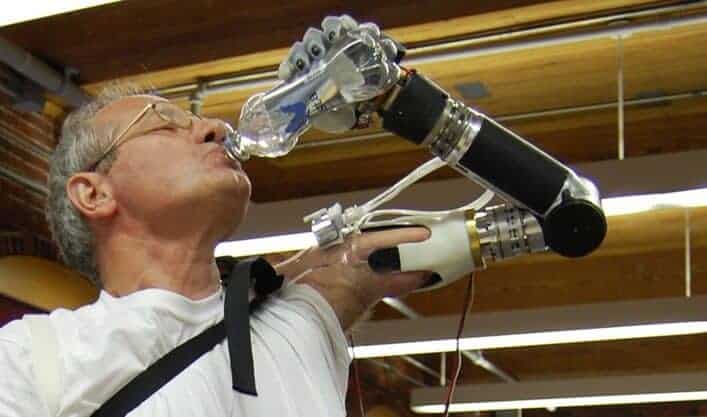The U.S. Food and Drug Administration (FDA) today allowed marketing of the DEKA Arm System, the first prosthetic arm that can perform multiple, simultaneous powered movements controlled by electrical signals from electromyogram (EMG) electrodes.
EMG electrodes detect electrical activity caused by the contraction of muscles close to where the prosthesis is attached. The electrodes send the electrical signals to a computer processor in the prosthesis that translates them to a specific movement or movements.
The EMG electrodes in the DEKA Arm System convert electrical signals into up to 10 powered movements, and it is the same shape and weight as an adult arm. In addition to the EMG electrodes, the DEKA Arm System contains a combination of mechanisms including switches, movement sensors, and force sensors that cause the prosthesis to move.
“This innovative prosthesis provides a new option for people with certain kinds of arm amputations,” said Christy Foreman, director of the Office of Device Evaluation at the FDA’s Center for Devices and Radiological Health. “The DEKA Arm System may allow some people to perform more complex tasks than they can with current prostheses in a way that more closely resembles the natural motion of the arm.”
The FDA reviewed clinical information relating to the device, including a 4-site Department of Veterans Affairs study in which 36 DEKA Arm System study participants provided data on how the arm performed in common household and self-care tasks. The study found that approximately 90 percent of study participants were able to perform activities with the DEKA Arm System that they were not able to perform with their current prosthesis, such as using keys and locks, preparing food, feeding oneself, using zippers, and brushing and combing hair.
The DEKA Arm System can be configured for people with limb loss occurring at the shoulder joint, mid-upper arm, or mid-lower arm. It cannot be configured for limb loss at the elbow or wrist joint.
Data reviewed by the FDA also included testing of software and electrical and battery systems, mitigations to prevent or stop unintended movements of the arm and hand mechanisms, durability testing (such as ability to withstand exposure to common environmental factors such as dust and light rain), and impact testing.
The FDA reviewed the DEKA Arm System through its de novo classification process, a regulatory pathway for some novel low- to moderate-risk medical devices that are first-of-a-kind.
The DEKA Arm System is manufactured by DEKA Integrated Solutions in Manchester, N.H.
If our reporting has informed or inspired you, please consider making a donation. Every contribution, no matter the size, empowers us to continue delivering accurate, engaging, and trustworthy science and medical news. Independent journalism requires time, effort, and resources—your support ensures we can keep uncovering the stories that matter most to you.
Join us in making knowledge accessible and impactful. Thank you for standing with us!

